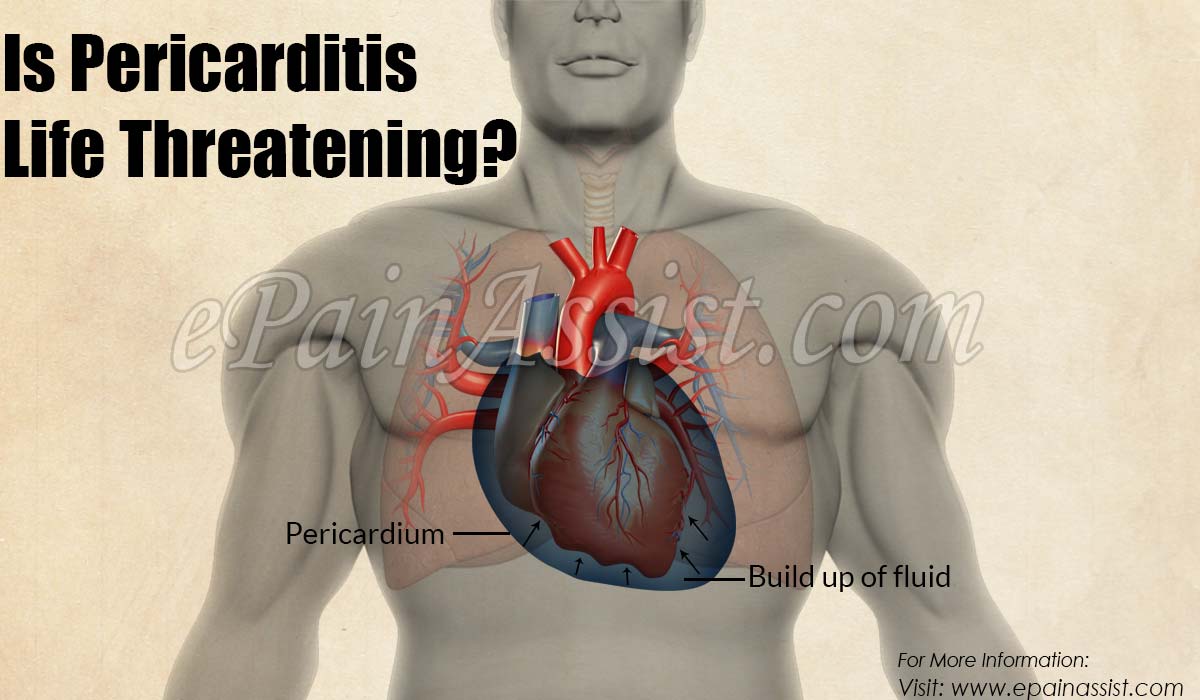The step to understand an answer is to first comprehend the question. So to answer whether pericarditis is life threatening or not, we should first understand what pericarditis is.
Pericarditis is the inflammation of the pericardium, the two layers of a sac-like tissue surrounding the heart. The function of pericardium is to keep the heart in position when we are in motion such as walking or running. Generally, a small amount of fluid is normally present in between the two layers of pericardium to prevent friction. An inflammation usually results in a build-up of this fluid leading to poor function of the heart.
Types of Pericarditis
Pericarditis can be broadly classified into two types:
- Acute pericarditis, which occurs suddenly and typically, does not last long.
- Chronic pericarditis, which develops over a period of time and the symptoms persist beyond 3 months or is recurrent.

Is Pericarditis Life Threatening?
The question is whether pericarditis is life threatening or not. Taking immediate medical care, emergency help and punctual follow up, pericarditis is just another disease that can be cured with proper medical intervention when done immediately, which is true for all diseases. Prevention is better than cure and prompt treatment will prevent the further complications. It can be life threatening if no proper care is taken.
Pericarditis mostly presents as a sharp and stabbing pain that might mimic a heart attack. It might on occasions be dull pain too. The pain begins in the middle of the chest and radiates to the upper back or neck. The chest pain sometimes worsens on lying down, coughing and swallowing. It is often relieved on sitting up. The pain might also cause painful breathing. Other symptoms include fever, chills (when it is caused due to infection), shortness of breath and difficulty in swallowing. In chronic cases weakness, fatigue and malaise may be the presentation too. Mostly men are at an increased risk of developing pericarditis.
What are the Causes of Pericarditis?
The exact cause of pericarditis is unknown, so mostly it is idiopathic. The other common causes include infections such as viral, bacterial (TB), HIV/AIDS or fungal. It might also present in inflammatory diseases such as rheumatoid arthritis, SLE, ankylosing spondylitis, scleroderma, inflammatory bowels disease, heart diseases such as Dressler’s syndrome, heart attack causing irritation and inflammation of the pericardial lining, trauma to the chest, kidney failure, tumors including leukemia, radiation therapy to the chest and also due to certain medications such as procainamide, hydralazine, phenytoin, isoniazid and immunosuppressant drugs.
How is Pericarditis Diagnosed?
Pericarditis is usually confirmed with past medical history and physical examination. The history of pain and the character would indicate towards pericarditis. A history of previous chest infection is important, especially if it is recurrent. The most common physical finding is a pericardial frictional rub. Also it might present with signs of fluid in the pericardium, known as pericardial effusion or fluid in the lungs, known as pleural effusion. Heart sounds may also be distant or muffled.
The imaging tests may be done to check the heart and tissue layer, which include X-ray of the chest, electrocardiogram, echocardiogram, ultrasound of the heart, radionuclide scan or CT scan. Troponin I test will show further heart muscle damage. Other tests may include CBC, blood culture, CRP test, ESR, HIV test, rheumatoid factor and TB skin test.
What are the Treatment Options?
On most occasions, pericarditis is viral in nature and usually anti-inflammatory drugs or NSAIDs are given, such as ibuprofen or naproxen. A short course of narcotic drugs may be used to relieve severe pain.
The other causes of pericarditis are treated accordingly. If it is due to bacterial infection antibiotics are used, and antifungals are used for fungal infections. Other medicines that may be used are corticosteroids for e.g. prednisone, diuretics (for removing of excess fluid), and colchicine to prevent swelling caused by inflammation. There are also treatment options that are used in severe cases of pericarditis such as pericardiocentesis (fluid drainage from the sac), pericardiotomy (making a small hole in the pericardium for drainage of infected fluid in the abdominal cavity) and also pericardiectomy that is performed for recurrent pericarditis (severing a part of the pericardium).
What are the Complications of Severe Pericarditis?
There are also complications of untreated pericarditis such as:
Cardiac Tamponade: Cardiac tamponade is the most dangerous complication which results in the accumulation of large amount of fluid leading to decrease in blood pressure and altered heart function. It is treated with pericardiocentesis and pericardiotomy. It is a medical emergency and the patient may present shock, low blood pressure, difficulty breathing or congestive cardiac failure.
Constrictive Pericarditis: This mostly occurs due to chronic/recurrent pericarditis that causes scarring and thickening of the sac-like covering and the heart muscle. It is treated with pericardiectomy.
Also Read:
